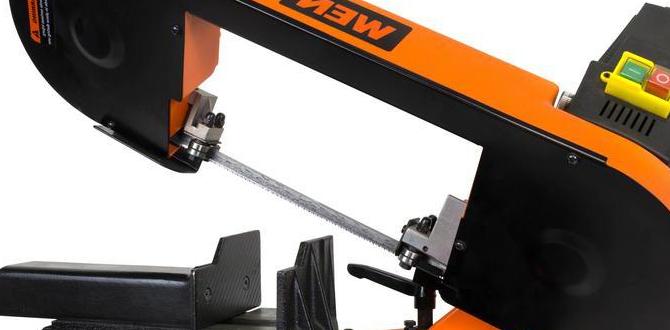Quick Summary: Driving nails in tight corners is easier than you think! Use specialized tools like angled nail guns or flex-head screwdrivers, and precise hammer techniques. This guide provides proven methods to confidently tackle those tricky spots.
Ever found yourself wrestling with a hammer, trying to get a nail into a spot so tight it feels impossible? You’re not alone! Many DIYers face this challenge, especially when working on trim, cabinetry, or furniture. Those awkward angles and confined spaces can make even simple tasks feel frustrating. But don’t let those tight corners get the best of you. With the right techniques and a few clever tricks, you can drive nails precisely where you need them, achieving professional-looking results.
This guide is your go-to resource. We’ll break down exactly how to tackle those nail-driving challenges, no matter how snug the space. We’ll cover everything from choosing the right tools to mastering specific hammer swings. Get ready to conquer those fiddly spots and boost your woodworking confidence!
Table of Contents
The Challenge of Tight Corners
Working in tight corners presents several unique difficulties when it comes to driving nails. The primary issue is limited space for your tools and your hands. This constrains your ability to swing a hammer effectively or position a nail gun accurately. You might find:
- Restricted Swing: A traditional hammer needs room to build momentum. In a tight corner, you might only get a small, awkward flick of the wrist, delivering little force.
- Obstacles: Adjacent walls, cabinets, or other finished surfaces can get in the way, preventing you from getting a straight shot at the nail head.
- Visibility Issues: It can be hard to see exactly where the nail is going and ensure it’s straight, leading to bent nails or damage to surrounding materials.
- Hand Vulnerability: Keeping your fingers safe while hammering in a confined space is a significant concern.
These factors combine to make driving nails in tight corners a common frustration for anyone tackling DIY projects. But with a few smart approaches, this frustration can become a thing of the past.
Essential Tools for Tight Corners
The right tool can make all the difference. While a standard hammer might fail you, several tools are specifically designed or adapted to help you navigate tight spaces.
1. Specialized Nail Guns
For speed and consistent results, nail guns are invaluable. Certain types are better suited for corners:
- Brad Nailers and Finish Nailers: These are smaller, lighter, and often feature a slim nose piece that can get into tighter spots than framing nailers. They drive thinner headless nails (brads) or small-headed nails (finish nails), perfect for trim and molding.
- Angled Nailers: These nail guns have their magazine set at an angle to the driving head. This allows you to get the tool closer to adjoining surfaces, letting you drive nails at an angle into the corner where a straight nailer wouldn’t fit. A handy resource for understanding different nailer types is Nail Gun Depot’s Buyer’s Guides, which offers detailed comparisons.
- Narrow Crown Staplers: While not strictly a nailer, narrow crown staplers drive staples with thin legs that can function like headless nails and are often more compact, making them excellent for very tight woodworking applications.
Tips for Using Nail Guns in Tight Corners:
- Nail Orientation: For angled nailers, ensure the magazine is angled away from any visible surfaces.
- Tip Adjustment: Many nail guns have an adjustable depth setting. Start shallow and increase as needed to avoid over-penetration.
- Sequential Firing: Use sequential firing mode for precision placement rather than rapid fire.
- Safety First: Always wear safety glasses. Keep your free hand clear of the firing path.
2. Modified Hammers and Driving Tools
If a nail gun isn’t an option, you can adapt traditional methods:
- Offset or Sidewinder Hammers: These hammers have the striking face offset from the handle or are L-shaped. This allows you to get the hammerhead flush against a surface while still striking the nail head squarely. They are fantastic for getting “beside” an object to nail into a corner.
- Magnetic Nail Setters: These tools have a magnetic tip that holds the nail in place, allowing you to position it accurately without your fingers in the danger zone. You then use a regular hammer to drive the nail. Search for “magnetic nail setter tool” for examples.
- Flexible Shaft Screwdrivers (for screws): While this guide focuses on nails, if your project allows for screws in tight spots, an electric screwdriver with a flexible shaft adapter can be a lifesaver. Some specialty tools also allow for countersinking screws in tight areas.
- Offset Screwdrivers: Similar to offset hammers, these allow you to turn a screw head when access is to the side.
3. Nail Selection
The type of nail you use matters, especially in tight spots:
- Brads and Finish Nails: These thin nails with small heads are less likely to split wood in confined areas and are easier to drive accurately.
- Screws: For ultimate holding power and ease of insertion in tricky spots with the right driver, consider screws.
- Specialty Nails: Some manufacturers produce very short or uniquely shaped nails for specific applications.
Proven Techniques for Hammering Nails in Tight Corners
When you don’t have a nail gun or need that extra precision, mastering your hammer technique is key.
1. The “Two-Handed” or “Flick” Method
This is your go-to for very confined spaces where a full swing is impossible.
- Position the Nail: Hold the nail against the surface where you want it. You can use a small pair of pliers or a specialized nail holder to keep your fingers clear.
- Initial Tap: Gently tap the nail head with the hammer. Just enough to set it into the wood slightly and make it stand on its own.
- Grip Adjustment: Hold the hammer closer to the head. This gives you more control and allows for a more precise strike.
- The “Flick”: Use a controlled wrist motion rather than a full arm swing. Focus on hitting the nail head squarely with each small, deliberate movement.
- Drive it In: Continue with controlled wrist flicks, ensuring each strike lands true.
2. The Angled Approach
Sometimes, driving the nail straight in isn’t feasible. An angled nail can be just as effective and much easier to insert.
- Identify the Angle: Look at the corner. Can you hit the nail at a 45-degree angle into the corner joint? This often provides enough surface area for the nail to grip.
- Hold Firm: Use pliers or a nail holder to keep the nail steady at your chosen angle.
- Initial Set: Tap the nail gently to set it at the correct angle so it doesn’t shift.
- Controlled Strikes: Use your hammer with controlled wrist action, striking the nail head squarely along its length. The angle helps you get a better hammer approach.
- Consider the Material: Be mindful of what you’re nailing into. Thinner material might require a shallower angle or a shorter nail to avoid poking through.
3. Using a Nail Set
Once a nail is mostly in but not flush, a nail set is perfect for countersinking it slightly, especially in visible areas, and it’s great for those final, awkward taps.
- Nail Placement: Drive the nail until the head is just slightly raised above the surface, or just barely below if you prefer.
- Position the Nail Set: Place the tip of the nail set directly onto the nail head.
- Hold Steady: Ensure the nail set is perpendicular to the nail head and the surface.
- Tap and Drive: Strike the end of the nail set with your hammer. Use firm but controlled taps. This drives the nail head down without marring the surrounding wood.
- Watch for Oversink: Don’t hit too hard, or you’ll drive the nail head too deep into the wood, potentially weakening the connection or creating an unsightly hole.
4. The Safety Pinch Technique (for very small nails)
This requires care but can work for tiny brad nails where even pliers are too large.
- Grip the Nail Shaft: Hold the nail between your thumb and index finger, very close to the head.
- Tap to Set: Gently tap the nail head with your hammer to set it into the wood.
- Withdraw Fingers: Quickly pull your fingers away as you begin the first driving swing.
- Controlled Swings: Use small, controlled swings to finish driving the nail.
Important Safety Note: This technique carries a higher risk of hitting your fingers. Always prioritize using pliers or a dedicated nail holder when possible. If you choose this method, start very slowly and focus on precision.
When to Use Which Method? A Quick Guide
Choosing the right approach depends on your tools, the materials, and the specific space.
| Scenario | Recommended Tool/Method | Why it Works |
|---|---|---|
| Working with trim inside narrow cabinets or closets. | Slim-nosed Brad/Finish Nailer, Angled Nailer | Compact size, angled magazine for access. |
| Attaching small decorative pieces where precision is key. | Magnetic Nail Setter + Hammer, or Safety Pinch Method (with extreme caution) | Minimal finger exposure, controlled taps for accuracy. |
| Nailing into a corner joint between two pieces of wood. | Angled Approach with Hammer, Angled Nailer | Allows nail to bite into both surfaces effectively. |
| Driving numerous nails quickly in accessible tight spots. | Pneumatic or Cordless Brad/Finish Nailer | Speed and efficiency when space permits a standard approach. |
| Situations requiring ultimate control and minimal risk of damage. | Offset Hammer + Pliers/Nail Holder | Precise strikes and secure nail holding. |
Mastering the Hammer Swing in Confined Spaces
The physics of a good hammer swing are compromised in tight spots, but you can adapt:
Instead of a full chop from the shoulder, focus on utilizing your wrist and elbow. Think of it as a controlled, sharp tap rather than a powerful blow. The grip is crucial: hold the hammer closer to the head for better precision and control. This reduces the leverage but increases accuracy. Imagine you’re trying to place the nail with a series of accurate jabs, each one slightly deeper than the last.
It’s also about the follow-through, even if minimal. A slight follow-through after contact ensures you’re driving the nail straight and not bending it with a glancing blow. Practice on scrap wood to get a feel for this modified motion. You’ll find that a bit of focused wrist action can deliver surprising force when needed!
For more on tool safety and best practices, the Occupational Safety and Health Administration (OSHA) provides comprehensive guidelines for using hand and power tools, including safe hammering techniques.
Specific Project Examples
Let’s look at how these techniques apply to common DIY projects:
1. Installing Baseboards and Trim
- Inside Corners: When attaching baseboards to a corner stud, you might need to drive nails at an angle. An angled nailer simplifies this, but with a hammer, a slight 45-degree angle for the nail and controlled wrist flicks work well. Use pliers to hold the nail steady.
- Attaching to Existing Walls: If you’re attaching a thin piece of trim to an existing wall surface or cabinet side in a tight nook, a slim brad nailer is ideal. If hammering, use a magnetic nail setter and focus on precise taps.
2. Cabinetry and Furniture Building
- Joining Small Parts: When assembling small boxes or intricate furniture components, space is often at a premium. Small brad nails are preferred here. Use a nail set to drive them flush or slightly below the surface for a clean finish.
- Attaching Back Panels: If you’re attaching a thin back panel to a cabinet in a tight corner, using staples from a narrow crown stapler can be easier than nails due to the tool’s compact size.
3. Repair Work
- Fixing Loose Trim: Often, trim in tight spots loosens. You might need to drive a small nail through the face of the trim into the stud or substrate behind it. A magnetic nail setter and careful hammering are usually the best bet here.
- Repairing Shelving: If a shelf bracket in a tight corner needs reinforcement, you might need to nail into the side of the cabinet. An offset hammer or the carefully controlled flick method can be employed.
Safety First, Always!
Working in tight spaces introduces specific safety risks. Keep these in mind:
- Eye Protection: Always wear safety glasses, even for small tasks. Debris can fly unpredictably in confined spaces.
- Finger Safety: Never place your fingers directly in the path of a hammer or nail gun. Use pliers, nail holders, or magnetic setters whenever possible.
- Tool Control: Ensure you have a stable grip on your tool and a secure stance. Slipping can cause damage or injury.
- Clear the Area: Before you start, clear away any unnecessary clutter that could cause you to trip or lose balance.
- Ventilation: If using pneumatic nail guns, ensure good ventilation as the air lines can be a tripping hazard.
FAQ
Q1: What’s the easiest way to hold a nail straight in a tight corner?
A1: Use a pair of needle-nose pliers or a specialized nail holder. These tools grip the nail shaft securely, allowing you to position it precisely and keep your fingers out of harm’s way.
Q2: Can I use a regular hammer for all tight corner jobs?
A2: While a regular hammer can work for some basic tasks with careful technique, specialized tools make the job much easier and safer. If you find yourself frequently facing tight corners, investing in a slim-nosed nailer or an offset hammer is highly recommended.
Q3: How do I avoid damaging the surrounding wood when hammering in a tight space?
A3: Use controlled, light taps initially to set the nail. For driving it fully, use the “flick” method with short, precise wrist movements. If you need to sink the nail head below the surface, use a nail set with gentle hammer taps to prevent over-driving and marring the wood.
Q4: What if the nail bends when I try to drive it in a tight corner?
A4: A bent nail is often a sign of insufficient power, an improper angle strike, or hitting a knot. In tight spaces, it can also mean you don’t have enough room for a clean strike. Try backing the nail out and repositioning it. Ensure you’re



